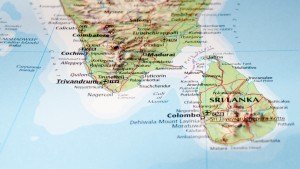In a now well-publicised and notorious case, in August 2010, 13 nails and 5 needles were surgically removed from the body of a Sri Lankan migrant domestic worker on her return to Sri Lanka from working as a housemaid in a private household in Saudi Arabia. She said that her employers had hammered 24 nails and needles into her body when she complained of overwork.
While shocking, this is by no means an isolated incident. The local Sri Lankan newspapers and international human rights organisations regularly report cases of physical, psychological and sexual abuse of female migrant domestic workers employed in countries in the Middle East. These workers originate not only in Sri Lanka, but also in a variety of sending countries with high proportions of workers migrating for low skilled work, such as Bangladesh, the Philippines and Indonesia.
 Any understanding of the root causes of the vulnerability of these women migrant workers has reference to both sending and receiving contexts, the nature of domestic work, and socio-demographic characteristics of the workers. Domestic work as ‘invisible’ work performed within private households is not covered by labour and social protection regulations in most Middle Eastern countries, and, indeed, in many other countries, including Sri Lanka itself.
Any understanding of the root causes of the vulnerability of these women migrant workers has reference to both sending and receiving contexts, the nature of domestic work, and socio-demographic characteristics of the workers. Domestic work as ‘invisible’ work performed within private households is not covered by labour and social protection regulations in most Middle Eastern countries, and, indeed, in many other countries, including Sri Lanka itself.
What international protection is there?
The International Labour Organisation (ILO) estimates there are more than 53 million domestic workers, including migrant workers, globally, but this is almost certainly an under-estimate given that most labour market statistics do not capture this hidden category of workers. More than four fifths are women.
On 16 June 2011 the ILO adopted the Domestic Workers Convention (No. 189), stipulating conditions of decent work for domestic workers globally, including those migrating to work beyond the borders of their countries. As an international treaty it enshrines basic rights such as protection against all forms of abuse, harassment and violence, elimination of forced and child labour, freedom of association and the right to collective bargaining, elimination of discrimination in employment, fair conditions of work such as normal hours, overtime compensation, periods of rest, annual paid leave, a minimum wage where this exists for other workers, ensuring of safe and healthy working environments, social security protection not less favourable than that applied to workers in general, written contracts that are enforceable in countries of employment for migrant workers and the right to keep in their possession their identity and travel documents.
It also places responsibility on governments to regulate practices of private employment agencies to prevent fraudulent and abusive recruitment processes, and to strengthen co-operation between sending and receiving countries in applying and monitoring the provisions of the Convention. Significantly, the Gulf States (Bahrain, Kuwait, Oman, Qatar, Saudi Arabia, and the United Arab Emirates) eventually voted for a legally binding convention, whereas support was weaker among European States, and disappointingly the UK abstained from voting.
(How) does Sri Lanka protect its domestic workers?
 The Sri Lankan government has stated that it is looking into amending national laws to take into account domestic work and to ratifying the Convention, although an official policy announcement has not yet been made. Changing or clarifying the rights and entitlements of domestic workers within Sri Lanka has a long way to go. At present, domestic work may be covered by some provisions of the Industrial Disputes Act, including considering verbal agreements between employer and domestic worker as binding and the possibility of domestic workers seeking redress for unfair treatment through a labour tribunal. However, these provisions are little known and in any case do not provide sufficient provision against under-payment and lack of social protection.
The Sri Lankan government has stated that it is looking into amending national laws to take into account domestic work and to ratifying the Convention, although an official policy announcement has not yet been made. Changing or clarifying the rights and entitlements of domestic workers within Sri Lanka has a long way to go. At present, domestic work may be covered by some provisions of the Industrial Disputes Act, including considering verbal agreements between employer and domestic worker as binding and the possibility of domestic workers seeking redress for unfair treatment through a labour tribunal. However, these provisions are little known and in any case do not provide sufficient provision against under-payment and lack of social protection.
There is no official minimum wage for domestic workers in Sri Lanka, and they are not covered by any national social security regulations, so that, even after a lifetime of work, they are not legally entitled to a State or employer contributed pension and have to depend on the good will and charity of individual former employers to survive in their old age. The prevalence of child domestic workers - under age 18 but some falling within compulsory school age (5-14) and totally invisible in official statistics because of the illegality of their employment - is a particular cause for concern.
Female domestic workers continue to form a large proportion of Sri Lanka’s migrant workers. While the share of ‘housemaids’ has dropped over the past two decades alongside an increase in the share of male migrant workers in general, female domestic workers were 42% of all migrant workers departing for foreign employment in 2010, and the largest category in the 49% female share of total migrant workers.
The major receiving countries for female domestic workers over the past five years at least have been Saudi Arabia, Kuwait, and the United Arab Emirates. What is also most significant is the enormous economic contribution these women make both to their families left behind, and to the country as a whole. Private remittances, at around 50% in 2010, now form the largest net foreign exchange earner for Sri Lanka, surpassing traditional exports of tea, rubber and coconut. Around 60% of private remittances are from Middle Eastern countries.
Moving forward?
The Sri Lankan government currently appears to be focusing some effort into implementing the National Labour Migration Policy for Sri Lanka, launched in 2009. This policy document is structured into three main sections
- governance of the migration process
- protection of workers and their families
- linking migration and development
It covers the challenges as well as proposals for action relating to these three themes. It does appear to provide a positive way forward in recognising the importance of more organised regulation of migration processes and protection of vulnerable workers such as women migrating to the Middle East as domestic workers – including tighter control of recruitment agencies to prevent practices ranging from mis-information given to clients to outright trafficking , and setting up and monitoring systematic arrangements with receiving countries to protect fundamental labour and social security rights of workers and to address employer contractual violations.
However, there is also much emphasis on defining the vulnerability and susceptibility to exploitation and abuse of women who migrate as domestic workers predominantly according to their individual characteristics - i.e. their relative youth, low educational levels, limited language proficiency beyond mother tongue – and on ‘strategic’ proposals to reduce low skilled migration and increase more skilled migration to a broader range of destinations abroad to increase foreign exchange earnings as well as to tackle human rights violations.
Such approaches ultimately fail to recognise and address some of the core issues surrounding the under-valuing and exploitation of female domestic workers, whether at home or abroad; issues such as patriarchal family and societal ideologies and practices both in the sending and receiving contexts.
Visibility across borders
Why is it that in a country like Sri Lanka, where there is free and equitable access to primary, secondary and tertiary education for both sexes, large numbers of women end up in this situation? And most importantly, amidst local outcries about the exploitation and abuse of female domestic workers who travel abroad to work, why is there not enough recognition of the similarities and connection between the existence, and lack of rights and protection, of large numbers of (invisible) female domestic workers within Sri Lanka and those who migrate internationally for domestic work?